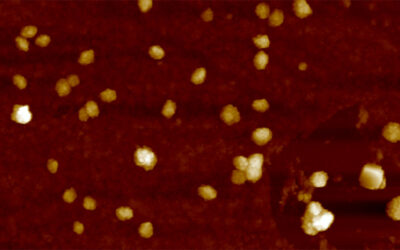Upconversion, converting infrared (IR) light into visible photons, holds promise for applications ranging from photovoltaic cells to bioimaging. Yet, achieving efficient broadband upconversion of IR light in pure inorganic or organic substances has been elusive ever since the conceptual establishment of upconversion in the 1960s. This is mainly because of the low and narrow absorption ability of rare earth ions that are typically diluted in an inorganic host lattice to entail upconversion. This limitation poses a strong restriction on the brightness of upconversion, thus holding back the technology transfer from bench to market.
 Now, Chen and Prasad et al. developed a hybrid inorganic-organic nanomaterial using a core-shell-shell structure that configures multiple energy cascaded pathways to empower super-efficient and broadband upconversion. This hybrid nanostructure comprises of three well-defined functional domains: (i) the inorganic core domain of fluoride nanocrystal doped with varying types of rare-earth elements, which is designated to produce rare-earth-element-specific multicolored upconversion; (ii) the inorganic shell layer, epitaxially grown onto the inorganic core domain.
Now, Chen and Prasad et al. developed a hybrid inorganic-organic nanomaterial using a core-shell-shell structure that configures multiple energy cascaded pathways to empower super-efficient and broadband upconversion. This hybrid nanostructure comprises of three well-defined functional domains: (i) the inorganic core domain of fluoride nanocrystal doped with varying types of rare-earth elements, which is designated to produce rare-earth-element-specific multicolored upconversion; (ii) the inorganic shell layer, epitaxially grown onto the inorganic core domain.
The inorganic shell protects the inorganic core nanocrystal from surface-related quenching effect, while also incorporating defined types of rare-earth ions as energy routers to migrate the harvested IR light from the outmost organic shell to the inorganic core domain; (iii) the outmost organic shell, whereby the IR-absorbing organic dyes are anchored on the inorganic core/shell nanocrystal surface for light harvesting. The nature of organic dyes enables the hybrid system to strongly absorb IR light in a wide spectral range (680-850 nm) that can be 10 times broader than rare earth ions. While the rare earth dopants in the inorganic shell layer establish synergistic multiple pathways to transfer the dye-harvested energy all the way down to the inorganic core nanoparticles with an unprecedented efficiency of 98%, entailing multicolor visible emissions with ultrahigh upconversion efficiencies of 12-16%.
This organic dye-sensitized core/active shell nanocrystals, with a shell doped with synergistic types of lanthanide ions, might provide practical opportunities for many photonic applications, such as multicolor displays and biological imaging.

















